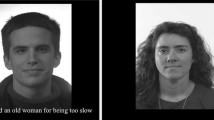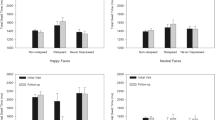Abstract
Memory for others’ sad affective facial expressions may be relevant to depression risk, given that biases have been linked to major depression and transient sad mood states. However, no study has addressed whether stable, subclinical dysphoria is associated with similar biases, or whether depression history might moderate a relationship between dysphoria and memory for affective facial stimuli. These questions were examined in the present study. Participants completed an incidental encoding task involving sad, happy, and neutral facial expression stimuli, and then they later completed a recognition memory task. Results indicated that dysphoria alone was not associated with memory differences. Rather, past depression moderated the effect of dysphoria such that dysphoric individuals with past depression showed greater recognition memory for sad faces relative to dysphoric/never depressed and nondysphoric/formerly depressed individuals. Findings are partially consistent with cognitive models of depression and could have implications for interpersonal functioning in susceptible or resilient individuals.
Similar content being viewed by others
Notes
This study was initiated prior SCID-5 publication.
Participants also completed the Pittsburgh Sleep Quality Inventory, which pertained to research project aims outside the scope of the present research questions of interest. Thus, these data are not reported in the present article.
A similar dysphoria-by-past depression-by-valence interaction effect was found when a four-way ANOVA including block order was conducted, F(2, 50) = 3.67, p = .06, η2 = .07. The main effect of block order showed a non-significant trend, F(2, 50) = 2.89, p = .10, η2 = .05
References
Adams, R. B., & Kleck, R. E. (2003). Perceived gaze direction and the processing of facial emotion. Psychological Science, 14, 644–647. https://doi.org/10.1046/j.0956-7976.2003.psci1479.x.
Allen, N. B., & Badcock, P. B. (2003). The social risk hypothesis of depressed mood: Evolutionary, psychosocial, and neurobiological perspectives. Psychological Bulletin, 129, 887–913. https://doi.org/10.1037/0033-2909.129.6.887.
Alloy, L. B., Fedderly, S. S., Kennedy-Moore, E., & Cohan, C. L. (1998). Dysphoria and social interaction: An integration of behavioral confirmation and interpersonal perspectives. Journal of Personality and Social Psychology, 74, 1566–1579. https://doi.org/10.1037/0022-3514.74.6.1566.
Barnard, P. J., & Teasdale, J. D. (1991). Interacting cognitive subsystems: A systemic approach to cognitive-affective interaction and change. Cognition and Emotion, 5(1), 1–39. https://doi.org/10.1080/02699939108411021.
Beck, A. T. (1967). Depression: Causes and treatment. Philadelphia: University of Philadelphia Press.
Beck, A. T., Steer, R. A., & Brown, G. K. (1996). Manual for the beck depression inventory-II. San Antonio: Psychological Corporation.
Bistricky, S. L., Ingram, R. E., & Atchley, R. A. (2011). Facial affect processing and depression susceptibility: Cognitive biases and cognitive neuroscience. Psychological Bulletin, 137, 998–1028. https://doi.org/10.1037/a0025348.
Bistricky, S. L., Atchley, R. A., Ingram, R. E., & O’Hare, A. (2014). Biased processing of sad faces: An ERP marker candidate for depression susceptibility. Cognition and Emotion, 28, 470–492. https://doi.org/10.1080/02699931.2013.837815.
Bistricky, S. L., Harrison, J., Tran, K., & Schield, S. (2016). Attending to emotional faces: Interpersonal connections and depression history. Journal of Social and Clinical Psychology, 35, 202–234. https://doi.org/10.1521/jscp.2016.35.3.202.
Bower, G. H. (1981). Mood and memory. American Psychologist, 36, 129–148. https://doi.org/10.1037/0003-066X.36.2.129.
Cuijpers, P., & Smit, F. (2004). Subthreshold depression as a risk indicator for major depressive disorder: A systematic review of prospective studies. Acta Psychiatrica Scandinavica, 109, 325–331. https://doi.org/10.1111/j.1600-0447.2004.00301.x.
Debener, S., Kranczioch, C., Herrmann, C. S., & Engel, A. K. (2002). Auditory novelty oddball allows reliable distinction of top-down and bottom-up processes of attention. International Journal of Psychophysiology, 46, 77–84. https://doi.org/10.1016/S0167-8760(02)00072-7.
Dimidjian, S., Barrera, M., Martell, C., Muñoz, R. F., & Lewinsohn, P. M. (2011). The origins and current status of behavioral activation treatments for depression. Annual Review of Clinical Psychology, 7, 1–38. https://doi.org/10.1146/annurev-clinpsy-032210-104535.
Erwin, R. J., Gur, R. C., Gur, R. E., Skolnick, B., Mawhinney-Hee, M., & Smailis, J. (1992). Facial emotion discrimination: I. Task construction and behavioral findings in normal subjects. Psychiatry Research, 42, 231–240. https://doi.org/10.1016/0165-1781(92)90115-J.
First, M. B., Spitzer, R. L., Gibbon, M., & Williams, J. B. W. (2002). Structured clinical interview for DSM-IV-TR axis I disorders, research version, non-patient edition (SCID-I/NP). New York: State Psychiatric Institute.
Gilboa-Schechtman, E., Erhard-Weiss, D., & Jeczemien, P. (2002). Interpersonal deficits meet cognitive biases: Memory for facial expressions in depressed and anxious men and women. Psychiatry Research, 113, 279–293. https://doi.org/10.1016/S0165-1781(02)00266-4.
Gotlib, I. H., Krasnoperova, E., Yue, D. N., & Joormann, J. (2004). Attentional biases for negative interpersonal stimuli in clinical depression. Journal of Abnormal Psychology, 113, 127–135. https://doi.org/10.1037/0021-843X.113.1.121.
Gur, R. C., Sara, R., Hagendoorn, M., Marom, O., Hughett, P., Macy, L., Turner, T., Bajcsy, R., Posner, A., & Gur, R. E. (2002). A method for obtaining 3-dimensional facial expressions and its standardization for use in neurocognitive studies. Journal of Neuroscience Methods, 115, 137–143. https://doi.org/10.1016/S0165-0270(02)00006-7.
Haaga, D., & Solomon, A. (1993). Impact of Kendall, Hollon, Beck, Hammen, and Ingram (1987). On treatment of the continuity issue in “depression” research. Cognitive Therapy and Research, 17, 313–324. https://doi.org/10.1007/BF01177657.
He, Y., Ebner, N. C., & Johnson, M. K. (2011). What predicts own-age bias in face recognition memory? Social Cognition, 29, 97–109. https://doi.org/10.1521/soco.2011.29.1.97.
Hunt, M., Auriemma, J., & Cashaw, A. C. (2003). Self-report bias and underreporting of depression on the BDI-II. Journal of Personality Assessment, 80, 26–30. https://doi.org/10.1207/S15327752JPA8001_10.
Ingram, R. E., Atchley, R. A., & Segal, Z. V. (2011). Vulnerability to depression: From cognitive neuroscience to prevention and treatment. New York: Guilford Press.
Isaac, L. (2012). Facing the future: Face-emotion processing deficits as a potential biomarker for various psychiatric and neurological disorders. Frontiers in Psychology, 12, 171–172. https://doi.org/10.3389/fpsyg.2012.00171.
Jermann, F., van der Linden, M., & D’Argembeau, A. (2008). Identity recognition and happy and sad facial expression recall: Influence of depressive symptoms. Memory, 16, 364–373. https://doi.org/10.1080/09658210801935413.
Joiner, T. E., & Timmons, K. A. (2000). Depression in its interpersonal context. In I. H. Gotlib & C. L. Hammen (Eds.), Handbook of depression (pp. 322–339). New York: Guilford Press.
Joiner, T. E., Alfano, M. S., & Metalsky, G. I. (1992). When depression breeds contempt: Reassurance seeking, self-esteem, and rejection of depressed college students by their roommates. Journal of Abnormal Psychology, 101, 165–173. https://doi.org/10.1037/0021-843X.101.1.165.
Joormann, J., Talbot, L., & Gotlib, I. H. (2007). Biased processing of emotional information in girls at risk for depression. Journal of Abnormal Psychology, 116(1), 135–143. https://doi.org/10.1037/0021-843X.116.1.135.
Joormann, J., & Vanderlind, M. W. (2014). Emotion regulation in depression: The role of biased cognition and reduced cognitive control. Clinical Psychological Science, 2(4), 402–421. https://doi.org/10.1177/2167702614536163.
Kendall, P. C., Hollon, S. D., Beck, A. T., Hammen, C. L., & Ingram, R. E. (1987). Issues and recommendations regarding use of the Beck depression inventory. Cognitive Therapy and Research, 11, 289–299. https://doi.org/10.1007/BF01186280.
Koster, E. H., De Lissnyder, E., Derakshan, N., & De Raedt, R. (2011). Understanding depressive rumination from a cognitive science perspective: The impaired disengagement hypothesis. Clinical Psychology Review, 31, 138–145. https://doi.org/10.1016/j.cpr.2010.08.005.
Lipps, G. E., Lowe, G. A., & Young, R. (2007). Validation of the Beck depression inventory-II in a Jamaican university student cohort. West Indian Medical Journal, 56, 404–408.
Lundqvist, D., Flyt, A., & Öhman, A. (1998). Karolinska directed emotional faces-KDEF [CD-ROM]. Stockholm: Department of Clinical Neuroscience, Psychology Section, Karolinska Institute.
Matt, G. E., Vazquez, C., & Campbell, W. (1992). Mood-congruent recall of affectively toned stimuli: A meta-analytic review. Clinical Psychology Review, 12, 227–255. https://doi.org/10.1016/0272-7358(92)90116-P.
McNair, Loor, D. M., & Droppleman. (1971). Manual for the profile of mood states. San Diego: Educational and Industrial Testing Service.
McNair, D.M., Lorr, M. & Droppleman, L.F. (1981). Manual for the profile of mood states. EdITS Educational and Industrial Testing Service, San Diego.
Minear, M., & Park, D. C. (2004). A lifespan database of adult facial stimuli. Behavior Research Methods, Instruments, & Computers, 36, 630–633. https://doi.org/10.3758/BF03206543.
Nolen-Hoeksema, S., Morrow, J., & Fredrickson, B. L. (1993). Response styles and the duration of episodes of depressed mood. Journal of Abnormal Psychology, 102, 20–28. https://doi.org/10.1037/0021-843X.102.1.20.
Otmakhova, N., Duzel, E., Deutch, A. Y., & Lisman, J. (2013). The hippocampal-VTA loop: The role of novelty and motivation in controlling the entry of information into long-term memory. In G. Baldassarre & M. Mirolli (Eds.), Intrinsically motivated learning in natural and artificial systems (pp. 235–254). Berlin, Heidelberg: Springer.
Phelps, E. A., & Sharot, T. (2008). How (and why) emotion enhances the subjective sense of recollection. Current Directions in Psychological Science, 17, 147–152. https://doi.org/10.1111/j.1467-8721.2008.00565.x.
Ridout, N., Astell, A., Reid, I., Glen, T., & O'Carroll, R. (2003). Memory bias for emotional facial expressions in major depression. Cognition & Emotion, 17, 101–122. https://doi.org/10.1080/02699930302272.
Ridout, N., Dritschel, B., Matthews, K., McVicar, M., Reid, I. C., & O’Carroll, R. E. (2009a). Memory for emotional faces in major depression following judgement of physical facial characteristics at encoding. Cognition & Emotion, 23, 739–752. https://doi.org/10.1080/02699930802121137.
Ridout, N., Noreen, A., & Johal, J. (2009b). Memory for emotional faces in naturally occurring dysphoria and induced sadness. Behavior Research and Therapy, 47, 851–860. https://doi.org/10.1016/j.brat.2009.06.013.
Roberts, J. E., Gilboa, E., & Gotlib, I. H. (1998). Ruminative response style and vulnerability to episodes of dysphoria: Gender, neuroticism, and episode duration. Cognitive Therapy and Research, 22, 401–423. https://doi.org/10.1023/A:1018713313894.
Romero, C., Master, A., Paunesku, D., Dweck, C. S., & Gross, J. J. (2014). Academic and emotional functioning in middle school: The role of implicit theories. Emotion, 14, 227–234. https://doi.org/10.1037/a0035490.
Ruys, K. I., & Stapel, D. A. (2008). Emotion elicitor or emotion messenger? Subliminal priming reveals two faces of facial expressions. Psychological Science, 19, 593–600. https://doi.org/10.1111/j.1467-9280.2008.02128.x.
Scher, C. D., Ingram, R. E., & Segal, Z. V. (2005). Cognitive reactivity and vulnerability: Empirical evaluation of a construct activation and cognitive diatheses in unipolar depression. Clinical Psychology Review, 25, 487–510. https://doi.org/10.1016/j.cpr.2005.01.005.
Sharot, T., & Phelps, E. A. (2004). How arousal modulates memory: Disentangling the effects of attention and retention. Cognitive, Affective, & Behavioral Neuroscience, 4(3), 294–306. https://doi.org/10.3758/CABN.4.3.294.
Sprinkle, S. D., Lurie, D., Insko, S. L., Atkinson, G., Jones, G. L., Logan, A. R., & Bissada, N. N. (2002). Criterion validity, severity cut scores, and test-retest reliability of the Beck depression inventory-II in a university counseling center sample. Journal of Counseling Psychology, 49, 381–385. https://doi.org/10.1037//0022-0167.49.3.381.
Tottenham, N., Tanaka, J., Leon, A. C., McCarry, T., Nurse, M., Hare, T. A., et al. (2009). The NimStim set of facial expressions: Judgments from untrained research participants. Psychiatry Research, 168, 242–249. https://doi.org/10.1016/j.psychres.2008.05.006.
Treynor, W., Gonzalez, R., & Nolen-Hoeksema, S. (2003). Rumination reconsidered: A psychometric analysis. Cognitive Therapy and Research, 27, 247–259. https://doi.org/10.1023/A:1023910315561.
Wells, T. T., Beevers, C. G., Robison, A. E., & Ellis, A. J. (2010). Gaze behavior predicts memory bias for angry facial expressions in stable dysphoria. Emotion, 10, 894–902. https://doi.org/10.1037/a0020022.
Williams, J. M. G., Van der Does, A. J. W., Barnhofer, T., Crane, C., & Segal, Z. S. (2008). Cognitive reactivity, suicidal ideation and future fluency: Preliminary investigation of a differential activation theory of hopelessness/suicidality. Cognitive Therapy and Research, 32, 83–104. https://doi.org/10.1007/s10608-006-9105-y.
Author information
Authors and Affiliations
Corresponding author
Ethics declarations
Conflict of Interest
On behalf of all authors, the corresponding author states that there is no conflict of interest.
Ethical Approval
All procedures performed in studies involving human participants were in accordance with the ethical standards of the institutional and/or national research committee and with the 1964 Helsinki declaration and its later amendments or comparable ethical standards.
Informed Consent
Informed consent was obtained from all individual participants included in the study.
Additional information
Publisher’s note
Springer Nature remains neutral with regard to jurisdictional claims in published maps and institutional affiliations.
Rights and permissions
About this article
Cite this article
Balderas, J., Schield, S., Harper, K. et al. Current dysphoria, past major depression, and memory for affective facial expressions. Curr Psychol 40, 3765–3772 (2021). https://doi.org/10.1007/s12144-019-00321-x
Published:
Issue Date:
DOI: https://doi.org/10.1007/s12144-019-00321-x




